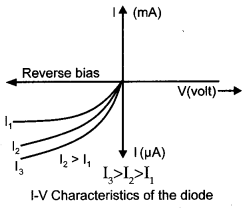CBSE Previous Year Question Papers Class 12 Physics 2017 Outside Delhi
True
Section – A
Question 1.
Nichrome and copper wires of same length and same radius are connected in series. Current I is passed through them. Which wire gets heated up more ? Justify your answer. [1]
Answer:
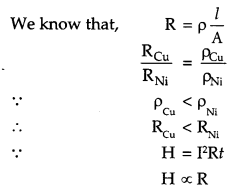
∴ Nichrome wire will get heated up more.
Question 2.
Do electromagnetic waves carry energy and momentum ? . [1]
Answer :
Yes, the electromagnetic waves carry energy and momentum because,

Question 3.
How does the angle of minimum deviation of a glass prism vary, if the incident violet light is replaced by red light ? Give reason. [1]


Question 4.
Name the phenomenon which shows the quantum nature of electromagnetic radiation. [1]
Answer:
Photoelectric effect.
Question 5.
Predict the polarity of the capacitor in the situation described below: [1]
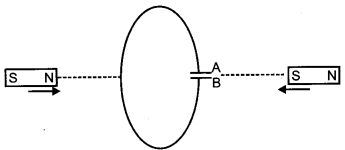
Answer:
A will be positive and B will be negative
Section – B
Question 6.
Draw the intensity pattern for single slit diffraction and double slit interference. Hence, state two differences between interference and diffraction patterns. [2]
OR
Unpolarised light is passed through a polaroid P
1
When this polarised beam passes through another polaroid P
2
and if the pass axis of P
2
makes angle 6 with the pass axis of P
2
, then write the expression for the polarised beam passing through P
2
. Draw a plot showing the variation of intensity when 9 varies from 0 to 2π.
Answer:
Intensity pattern for single slit diffraction:
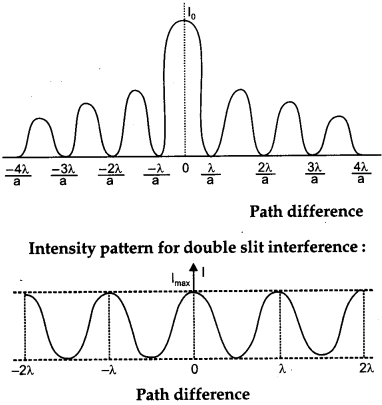
Difference between interference and diffraction patterns:
(a) Interference fringes are of the same width while diffraction fringes are not of the same width.
(b) In interference pattern all bright bands are of same intensity while in diffraction pattern all bright bands are not of same intensity.
OR
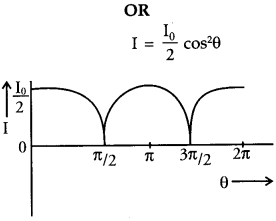
Question 7.
Identify the electromagnetic waves whose wavelengths vary as
(a) 10
-12
m < λ < 10
-8
m
(b) 10
-3
m < λ < 10
-1
m
Write one use for each. [2]
Answer:
(a) X – rays → To detect fractures in the human body.
(b) Microwaves → For aircraft navigation in RADAR systems.
Question 8.
Find the condition under which the charged particles moving with different speeds in the presence of electric and magnetic field vectors can be used to select charged particles of a particular speed. [2]
Answer :
(a) The velocity \(\vec{v}\) of the charged particles, and the \(\vec{E}\)and \(\vec{B}\) vectors, should be mutually perpendicular. Also the forces on q, due to \(\vec{E}\) and \(\vec{B}\) , must be oppositely directed.
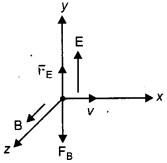
(b) If magnetic force = electrostatic force

Question 9.
A 12.5 eV electron beam is used to excite a gaseous hydrogen atom at room temperature. Determine the wavelengths and the corresponding series of the lines emitted. [2]
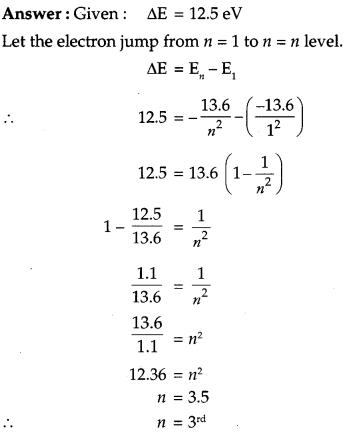
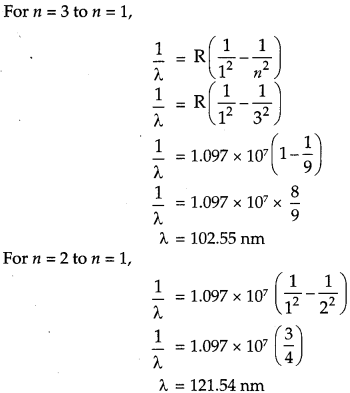
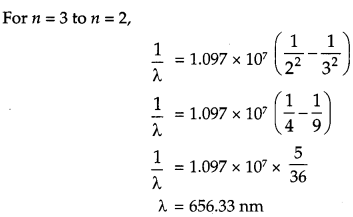
False
Question 10.
Write two properties of a material suitable for making
(a) a permanent magnet, and
(b) an electromagnet. [2]
Answer :
Properties of a material suitable for making permanent magnet:
- High retentivity.
- High coercivity.
Properties of a material suitable for making electromagnet:
- High permeability.
- Low retentivity.
Section – C
Question 11.
(a) The potential difference applied across a given resistor is altered so that the heat produced per second increases by a factor of 9 By what factor does the applied potential difference change ?
(b) In the figure shown, an ammeter A and a resistor of 4 Ω are connected to the terminals of the source. The emf of the source is 12 V having the internal resistance of 2Ω . Calculate the voltmeter and ammeter readings. [3]
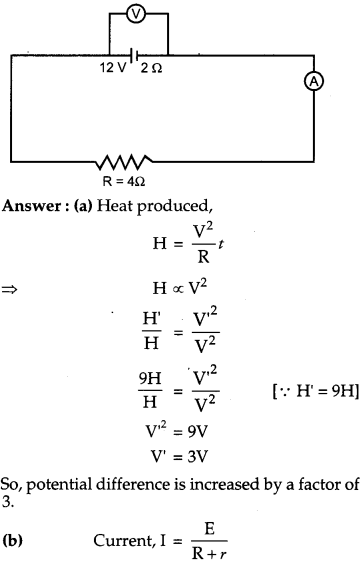
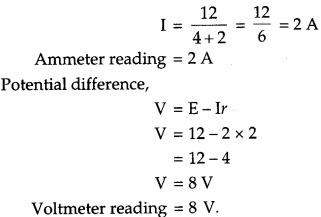
Question 12.
(a) How is amplitude modulation achieved ?
(b) The frequencies of two side bands in an AM wave are 640 kHz and 660 kHz respectively. Find the frequencies of carrier and modulating signal. What is the bandwidth required for amplitude modulation ? [3]
Question 13.
(a) In the following diagram, is the junction diode forward biased or reverse biased ?

(b) Draw the circuit diagram of a full wave rectifier and state how it works. [3]
Answer:
(a) Reverse biased.
(b) Full wave Rectifier:
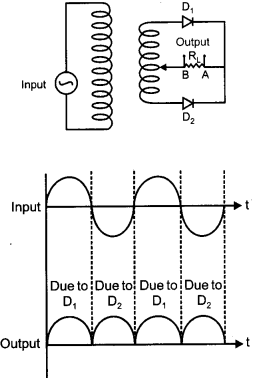
Diode D
1
conducts only when the junction is forward biased. Hence during first half cycle of input A.C., D
1
will conduct while D
2
will not and current in R
L
will flow from A to B. Diode D
2
is reverse biased. During second half cycle of input A.C., diode D
2
will conduct while D
1
will not conduct and current will again flow from A to B in Hence complete cycle will become unidirectional.
Question 14.
Using photon picture of light, show how Einstein’s photoelectric equation can be established. Write two features of photoelectric effect which cannot be explained by wave theory. [3]
Answer :
Einstein’s photoelectric equation : Einstein explained the various laws of photo¬electric emission on the basis of Planck’s quantum theory. According to Planck’s quantum theory, light radiations consist of tiny packets of energy called quanta. One quantum of light radiation is called a photon which travels with the speed of light.
The energy of a photon is given by,
E=hv
where h is Planck’s constant and u is the frequency of light radiation. Einstein assumed that one photo electron is ejected from a metal surface if one photon of suitable light radiation falls on it. Consider a photon of light of frequency u, incident on a photosensitive metal surface. The energy of the photon (= hv) is spent in two ways :
(a) A part of the energy of the photon is used in liberating the electron from the metal surface which is equal to the work function Φ
0
of the metal.
(b) The rest of the energy of the photon is used in imparting the kinetic energy to the emitted photo electron. If V
max
is the maximum velocity of the emitted photoelectron and m is its mass, then
Max. K.E. of the photoelectron,

This equation is called Einstein’s photoelectric equation.
Features of photoelectric effect which can not be explained by wave theory:
1. The wave theory could not explain the instantaneous process of photoelectric effect.
2. Maximum fcinetic energy’ of the emitted photoetectrous is independent of intensity of incident light.
Question 15.
(a) Monochromatic light of wavelength 589 run is incident from air on a water surface. If μ for water is 1.33, find the wavelength, frequency and speed of the refracted light,
(b) A double convex lens is made of a glass of refractive index 1.55, with both faces of the same radius of curvature. Find the radius of curvature required, if the focal length is 20 cm. [3]
Answer:
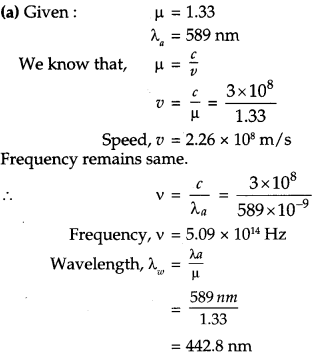
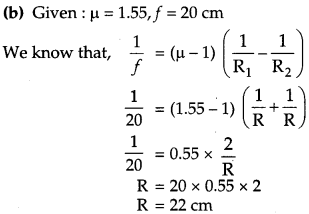
Question 16.
Define mutual inductance between a pair of coils. Derive an expression for the mutual inductance of two long coaxial solenoids of same length wound one over the other. [3]
OR
Define self-inductance of a coil. Obtain the expression for the energy stored in an inductor L connected across a source of emf.
Answer:
Mutual inductance is numerically equal to the induced e.m.f in the secondary coil when the current in the primary coil changes by unity. Suppose two long co-axial solenoids each of length l. We denote the area of the inner solenoid S
1
by A
1
and the number of turns per unit length by n
1
The corresponding quantities for the outer solenoid S
2
are A
2
and n
2
respectively. Let and N
2
be the total number of turns of coils S
1
and S
2
respectively.
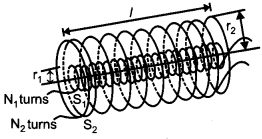
When a current I
2
is set up through S
2
, it in turn sets up a magnetic flux through S
1
Let us denote it by Φ
1.
The magnetic field due to current I
1
in S
1
is given by
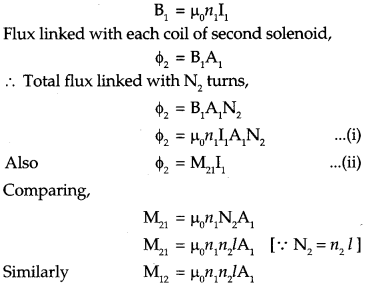
OR
Self inductance : Self inductance of a coil is equal to the magnitude of induced emf produced in the coil when rate of change of current through the coil is unity.
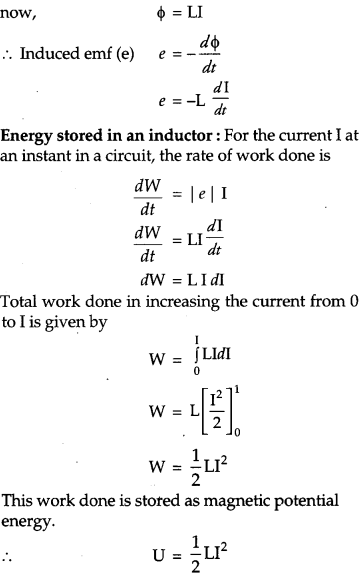
Question 17.
(a) Write the principle of working of a meter bridge.
(b) In a meter bridge, the balance point is found at a distance I
1
with resistances R and S as shown in the figure.
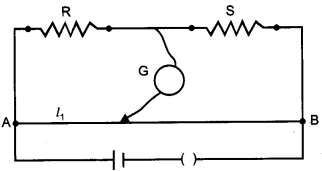
An unknown resistance X is now connected in parallel to the resistance S and the balance point is found at a distance I
2
. Obtain a formula for X in terms of I
2
, I
2
and S. [3]
Answer :
(a) Meter bridge works on the principle of balanced Wheatstone bridge i.e., when the bridge is balanced,
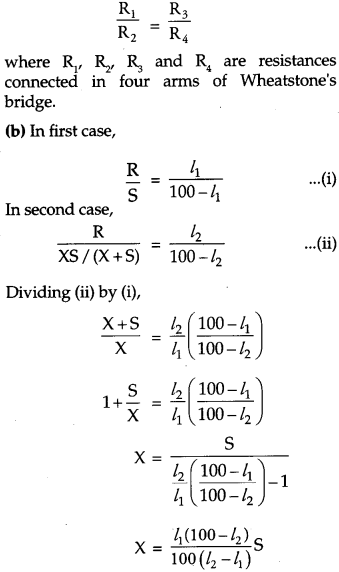
Question 18.
Draw a block diagram of a generalized communication system. Write the functions of each of the following : [3]
(a) Transmitter
(b) Channel
(c) Receiver
Question 19.
(a) Write the functions of the three segments of a transistor.
(b) The figure shows the input wave forms A and B for ‘AND’ gate. Draw the output waveform and write the truth table for this logic gate. [3]
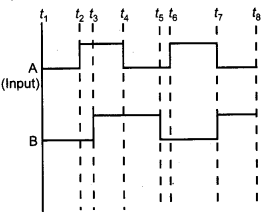
Question 20.
(a) Draw a ray diagram depicting the formation of the image by an astronomical telescope in normal adjustment.
(b) You are given the following three lenses. Which two lenses will you use as an eyepiece and as an objective to construct an astronomical telescope ? Give reason. [3]
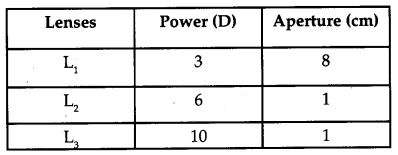
Answer:
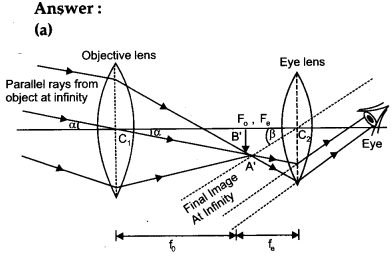
(b) An astronomical telescope should have an objective of large aperture and longer focal length while an eyepiece of small aperture and small focal length. Therefore, we will use L
1
as an objective and L
3
as an eyepiece.
Question 21.
(a) State Biot-Savart law and express this law in the vector form.
(b) Two identical circular coils, P and Q each of radius R, carrying currents 1 A and √3 A respectively, are placed concentrically and perpendicular to each other lying in the XY and YZ planes. Find the magnitude and direction of the net magnetic field at the centre of the coils. [3]
Answer:
(a) Biot-Savart Law :
It states that the magnetic field strength (dB) produced due to a current element I and length dl at a point having position vector \(\vec{r}\) relative to current element is
(i) directly proportional to the current I i.e., dB ∝ I
(ii) directly proportional to the length dl of the element i.e., dB ∝ dl.
(iii) directly proportional to sin θ, where θ is the angle between dl and r, i.e., dB ∝ sin θ .
(iv) inversely proportional to the square of the distance r from the current element i.e., dB ∝ 1/r
2
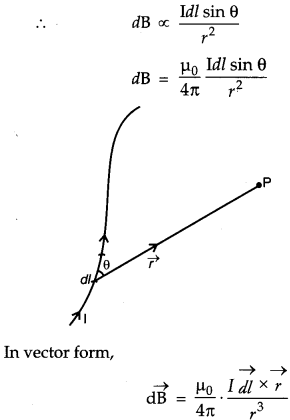
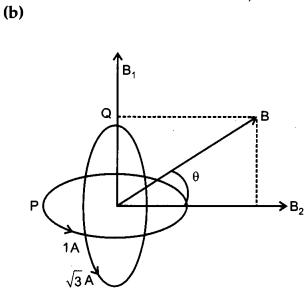
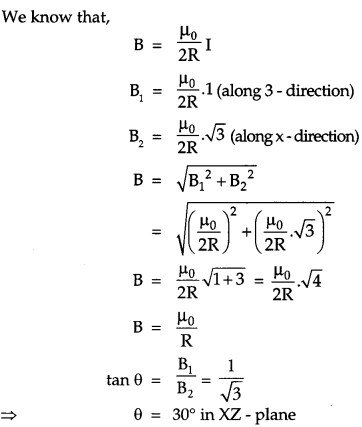
Question 22.
Two identical parallel plate capacitors A and B are connected to battery of V volts with the switch S closed. The switch is now opened and the free space between the plates of the capacitors is filled with a dielectric of dielectric constant K. Find the ratio of the total electrostatic energy stored in both capacitors before and after the introduction of the dielectric. [3]
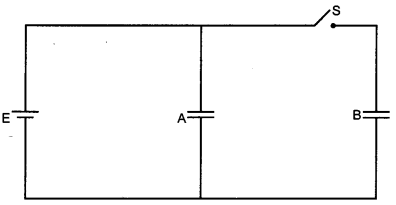
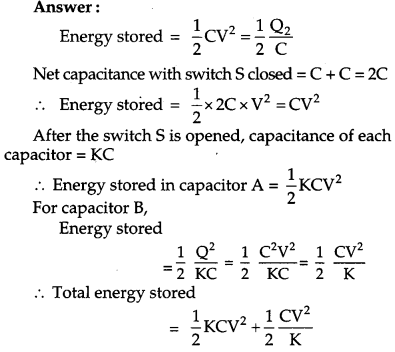
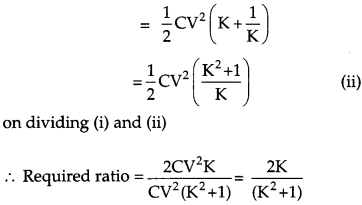
Section – D
Question 23.
Asha’s mother read an article in the newspaper about a disaster that took place at Chernobyl. She could not understand much from the article and asked a few questions from Asha regarding the article. Asha tried to answer her mother’s questions based on what she learnt in Class XII Physics. [4]
(a) What was the installation at Chernobyl where the disaster took place ? What, according to you, was the cause of this disaster ?
(b) Explain the process of release of energy in the installation at chemobyl.
(c) What, according to you, were the values displayed by Asha and her mother ?
Answer :
(a) Nuclear power plant was installed at Chemobyl where the disaster took place. The causes of this disaster are deficiencies in the reactor design and in operating regulations.
(b) Nuclear fission.
Section – E
24. (a) Derive an expression for the electric field E due to a dipole of length ‘2a’ at a point distant r from the center of the dipole on the axial line.
(b) Draw a graph of E versus r for r >> a.
(c) If this dipole were kept in a uniform external electric field E
0
diagrammatically represent the position of the dipole in stable and unstable equilibrium and write the expressions for the torque acting on the dipole in both the cases. [5]
OR
(a) Use Gauss’s theorem to find the electric field due to a uniformly charged infinitely large plane thin sheet with surface charge density σ.
(b) An infinitely large thin plane sheet has a uniform surface charge density + σ. Obtain the expression for the amount of work done in bringing a point charge q from infinity to a point, distant r, in front of the charged plane sheet.
Answer :
(a) Consider an electric dipole AB. The charges -q and +q of dipole are situated at A and B respectively, as shown in the figure. The separation between the charges is 2a. Electric dipole moment is given by
p = q . 2a …(i)
Consider a point P on the axis of dipole at a distance r from mid point O of electric dipole. The distance of point P from charge +q at B is,
BP = r-a
and distance of point P from charge -q at A is,
AP = r + a Let E
1
and E
2
be the electric field strengths at point P due to charges +q and -q respectively.
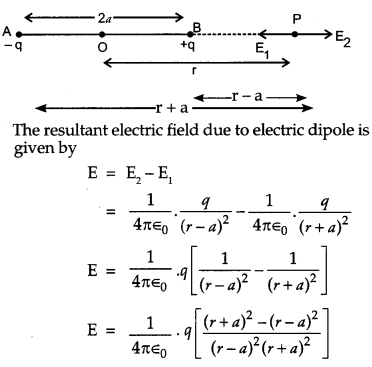
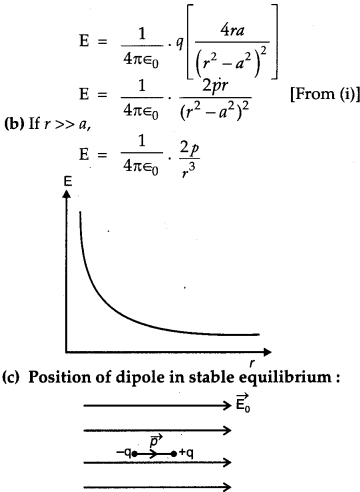
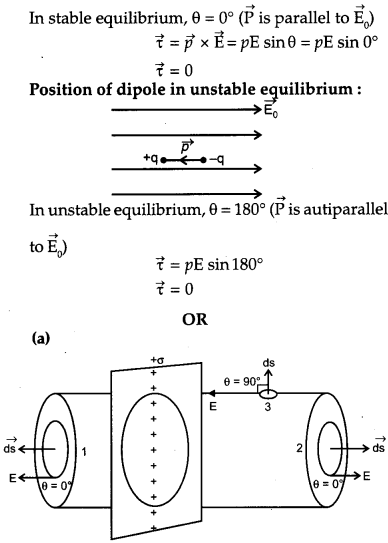
Let electric charge be uniformly distributed over the surface of a thin non-conducting infinite sheet. Let the surface charge density be σ.
According to Gauss theorem:
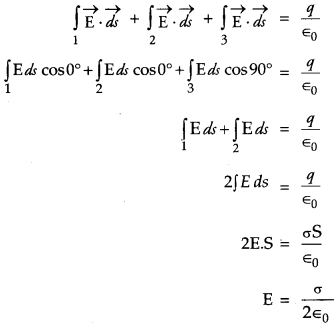
(b) The electric field due to a uniformly charged infinitely large thin sheet with surface charge density σ is,
\(\mathrm{E}=\frac{\sigma}{2 \epsilon_{0}}\) ……… (i)
The amount of work done in bringing a point charge q from infinity to a point, at a distance r is given by
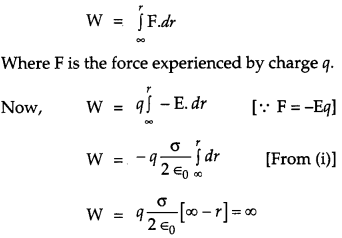
Question 25.
A device ‘X’ is connected to an ac source V = V
0
sin ωt. The variation of voltage, current and power in one cycle is shown in the following graph: [5]
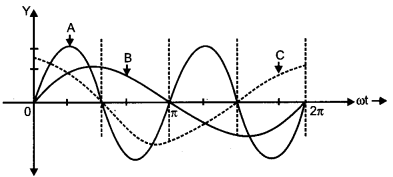
(a) Identify the device ‘X’.
(b) Which of the curves A, B and C represent the voltage, current and the power consumed in the circuit ? Justify your answer.
(c) How does its impedance vary with frequency of the ac source ? Show graphically.
(d) Obtain an expression for the current in the circuit and its phase relation with ac voltage.
OR
(a) Draw a labelled diagram of an ac generator. Obtain the expression for the emf induced in the rotating coil of N turns each of cross-sectional area A, in the presence of magnetic field B .
(b) A horizontal conducting rod 10 m long extending from east to west is falling with a speed 5.0 ms-1 at right angles to the horizontal component of the Earth’s magnetic field, 0. 3 x 10
-4
Wb m
2
. Find the instantaneous value of the emf induced in the rod.
Answer:
(a)The device X is a capacitor.
(b) The curves A,B and C represents power consumption,voltage and currentrespectively. Since, it is given V = V
0
sin ωt; this sinusoidal variation is represented by the curve B. In case of capacitor, current (I) leads the voltage by 90° which is being represented by curve C. Now, we know power is given by
P = V× I
So, the power would be positive for those cycles where both V and I are either positive or negative. Power would be negative when one of the two voltage or current, is negative. This illustration is followed by the curve A.
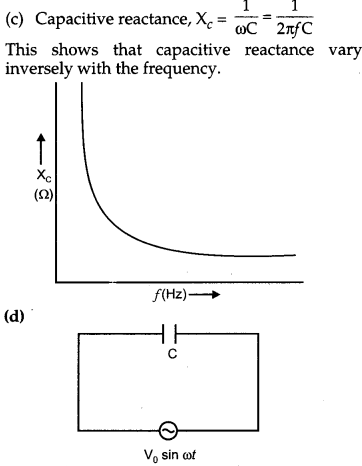
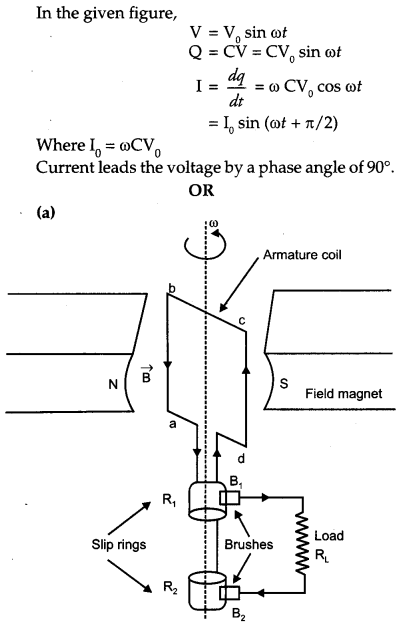
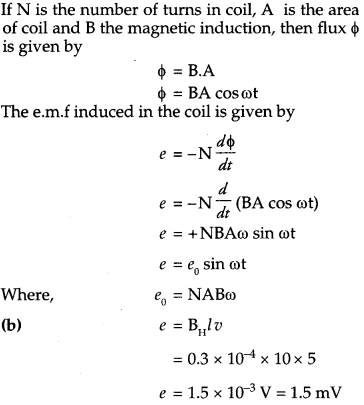
Question 26.
(a) Define wave front. Use Huygens’ principle to verify the laws of refraction.
(b) How is linearly polarised light obtained by the process of scattering of light ? Find the Brewster angle for air-glass interface, when the refractive index of glass = 1.5. [5]
OR
(a) Draw a ray diagram to show the image formation by a combination of two thin convex lenses in contact. Obtain the expression for the power of this combination in terms of the focal lengths of the lenses.
(b) A ray of light passing from air through an equilateral glass prism undergoes minimum deviation when the angle of incidence is 3/4th of the angle of prism. Calculate the speed of light in the prism
Answer :
(a) Wavefront : A wavefront is a continuous locus of all the particles of a medium which are vibrating in the same phase.
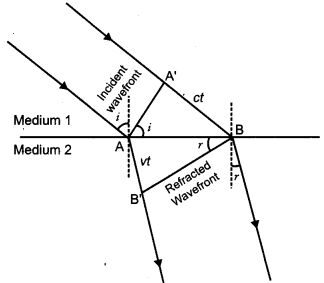
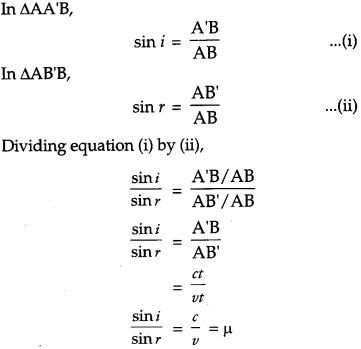
This is the snell’s law of refraction.
(b) When a beam of white light is passed through a medium containing particles whose size is of the order of wavelength of light, then the beam gets scattered. When the scattered light is viewed through an analyser in a direction at the right angle to the direction of incidence, it is found to be plane polarised. This is called polarization by scattering.
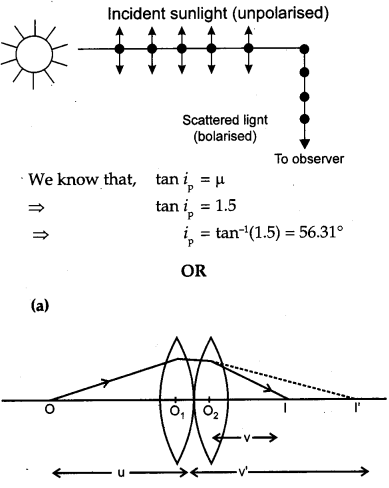
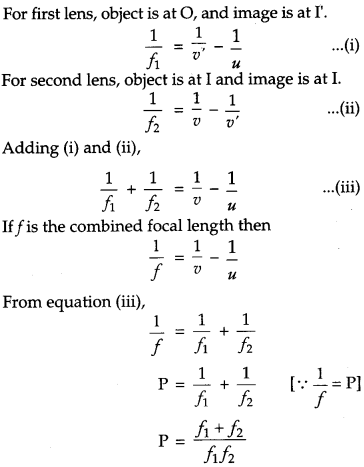
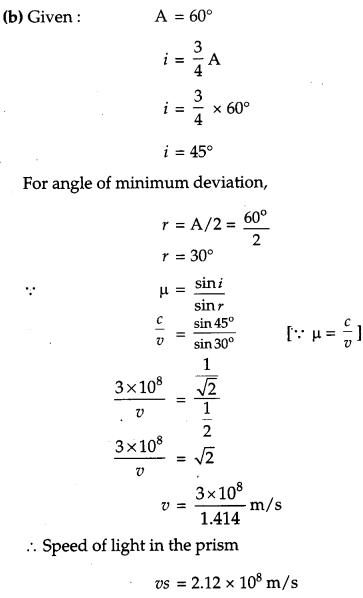
True
False
Question 1.
A bar magnet is moved in the direction indicated by the arrow between two coils PQ and CD. Predict the direction of the induced current in each coil. [1]

Answer:
From Q to P (i.e., anticlockwise) as seen from the left end.
From C to D (i.e., clockwise) as seen from the left end.
Question 2.
Write the relation for the speed of electromagnetic waves in terms of the amplitudes of electric and magnetic fields.
Answer:
\(c=\frac{E_{0}}{B_{0}}\)
Question 3.
Identify the electromagnetic waves whose wavelengths lie in the range
(a) 10
-11
< λ < 10
-14
m
(b) 10
-4
m < λ < 10
-6
m
Write one use of each. [2]
Answer:
(a) γ -rays
Use : For treatment of cancer.
(b) Infrared rays
Use : In remote control of T.V, V.C.R, etc.
Question 4.
The short wavelength limit for the Lyman series of the hydrogen spectrum is 913.4 A. Calculate the short wavelength limit for Balmer series of the hydrogen spectrum. [2]
Answer:
For short wavelength of Lyman series
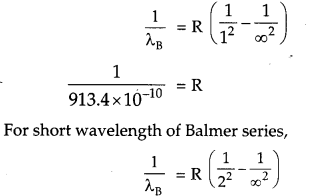
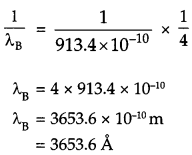
Question 5.
(a) Draw a ray diagram showing the formation of image by a reflecting telescope.
(b) Write two advantages of a reflecting telescope over a refracting telescope. [3]
Answer:
(a)
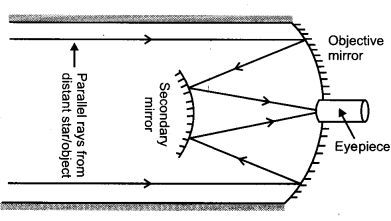
(b) 1. The image is free from chromatic aberration.
2. Spherical aberration can be eliminated by using parabolic mirror.
3. Light gathering power is more in reflecting telescope
Question 6.
Explain giving reasons for the following : [3]
(a) Photoelectric current in a photocell increases with the increase in the intensity of the incident radiation.
(b) The stopping potential (V
0
) varies linearly with the frequency (v) of the incident radiation for a given photosensitive surface with the slope remaining the same for different surfaces.
(c) Maximum kinetic energy of the photo electrons is independent of the intensity of incident radiation.
Answer :
(a) Since number of photo electrons emitted is directly proportional to the intensity of incident radiation therefore, as intensity increases the electron-hole pairs also increases.

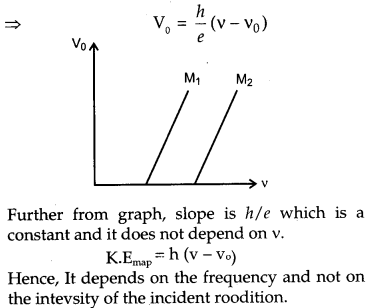
(c) As intensity increases, the number of photons increases but the energy remains same.
Question 7.
(a) In the following diagram which bulb out of B
1
and B
2
will glow and why ?
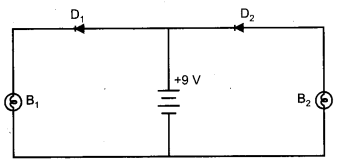
(b) Draw a diagram of an illuminated p-n junction solar cell.
(c) Explain briefly the three processes due to which generation of emf takes place in a solar cell. [3]
Answer :
(a) B
1
will glow because only diode D
1
is forward biased.
(b)
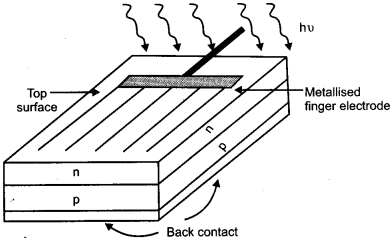
(c) Three process due to which generation of emf takes place in solar cell are :
- Generation : Generation of electron-hole pairs take place due to light.
- Separation : Separation of electron-hole pairs are due to electric field of depletion region.
- Collection : Electrons reach the n-side and are collected in front contact and holes are collected in the back contact.
Question 8.
(a) Draw the circuit diagram for studying the characteristics of a transistor in common emitter configuration. Explain briefly and show how input and output characteristics are drawn.
(b) The figure shows input wave forms A and B to a logic gate. Draw the output waveform for an OR gate. Write the truth table for this logic gate and draw its logic symbol. [3]

Question 9.
Two identical loops P and Q each of radius 5 cm are lying in perpendicular planes such that they have a common center as shown in the figure. Find the magnitude and direction of the net magnetic field at the common center of the two coils, if they carry currents equal to 3 A and 4 A respectively. [3]
Answer:
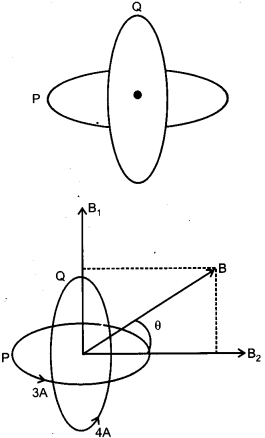
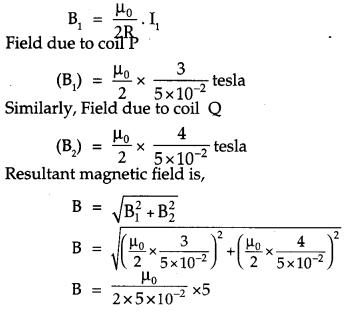
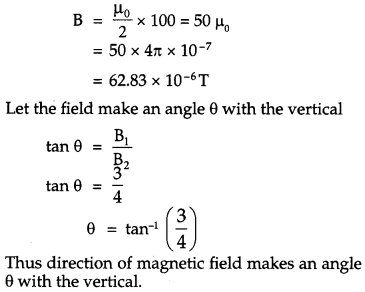
True
False__tailtailtailtailtailtailtailtailtailtailtailtailtailtailtailtailtailtailtailtailtailtailtailtailtailtailtailtailtailtailtailtailtailtailtailtailtailtailtailtailtailtailtailtailtailtailtailtailtailtailtailtailtailtailtailtailtailtailtailtailtailtailtailtailtailtailtailtailtailtailtailtailtailtailtailtailtailtailtailtailtailtailtailtailtailtailtailtailtailtailtailtailtailtailtailtailtailtailtailtailtailtailtailtailtailtailtailtail
Section-A
Question 1.
What is the direction of induced currents in metal rings 1 and 2 when current I in the wire is increasing steadily ?
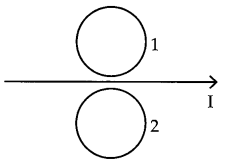
Answer:
Ring – 1 → Clockwise
Ring – 2 → Anticlockwise
Question 2.
In which directions do the electric and magnetic field vectors oscillate in an electromagnetic wave propagating along the x-axis ? [1]
Answer:
Electric component → Y – axis
Magnetic component → Z – axis
Question 3.
Why does current in a steady state not flow in a capacitor connected across a battery ? However momentary current does flow during charging or discharging of the capacitor. Explain. [2]
Answer :
When there is change in the electric flux there will be a displacement current and when flux is fixed the displacement as well as conduction current will be zero.
\(\mathrm{I}_{\mathrm{D}}=\epsilon_{0} \frac{d \phi_{\mathrm{E}}}{d t}\)
Question 4.
The ground state energy of hydrogen atom is -13.6 eV. If an electron makes a transition from an energy level – 1.51 eV to – 3.4 eV, calculate the wavelength of the spectral line emitted and name the series of hydrogen spectrum to which it belongs. [2]
Answer:
When energy is -1.51 eV then n = 3. When energy is – 3.4 eV then n- 2.
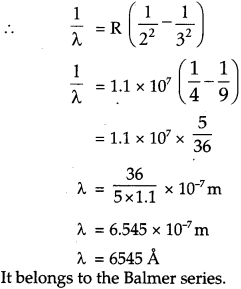
Question 5.
(a) Draw the circuit diagram of an n-p-n transistor amplifier in common emitter configuration.
(b) Derive an expression for voltage gain of the amplifier and hence show that the output voltage is in opposite phase with the input voltage. [3]
Question 6.
(a) Draw a ray diagram for the formation of image by a compound microscope.
(b) You are given the following three lenses. Which two lenses will you use as an eyepiece and as an objective to construct a compound microscope ?
| Lenses | Power (D) | Aperture (cm) |
| L 1 | 3 | 8 |
| L 2 | 6 | 1 |
| L 3 | 10 | 1 |
c) Define resolving power of a microscope and write one factor on which it depends. [3]
Answer :
(a) Ray diagram for compound microscope:
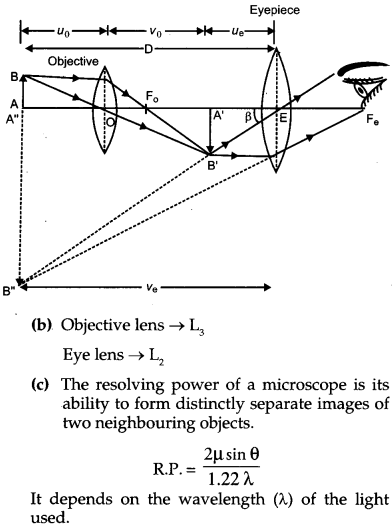
Question 7.
The following graph shows the variation of photo current for a photosensitive metal: [3]
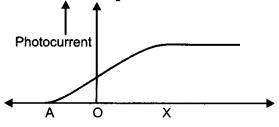
(a) Identify the variable X on the horizontal axis.
(b) What does the point A on the horizontal axis represent ?
(c) Draw this graph for three different values of frequencies of incident radiation v
1
, v
2
, and v
3
(v
1
> v
2
> v
3
) for same intensity.
(d) Draw this graph for three different values of intensities of incident radiation I
1
, I
2
and I
3
(I
1
> I
2
> I
3
) having same frequency.
Answer:
(a) X is collector plate potential.
(b) Stopping potential.
(c)
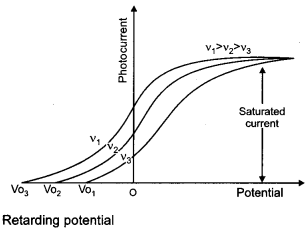
(d)
Question 8.
(a) In the following diagram ‘S’ is a semiconductor. Would you increase or decrease the value of R to keep the reading of the ammeter A constant when S is heated ? Give reason for your answer.
(b) Draw the circuit diagram of a photo diode and explain its working. Draw its I – V characteristics. [3]
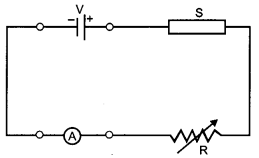
Answer:
(a) The value of R has to be increase because on heating, the conductivity of a semiconductor increases, i.e. resistance of S decreases on heating.
(b)
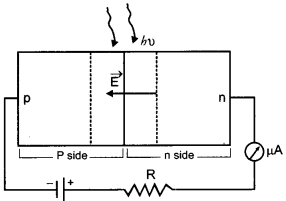
Working : In photodiode an electric field exists across the junction from n-side to p-side. When visible light with energy hv greater than energy gap (E
g
) illuminates the junction, then electron-hole pairs are generated in the depletion layer. Due to electric field electron moves towards n side and holes towards p-side give rise to an emf. when an external load is connected current flows.
